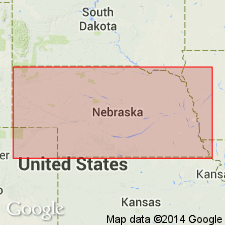
- Usage in publication:
-
- Pearl shales
- Modifications:
-
- Original reference
Summary:
Pg. 255. Pearl shales. Succession of red, blue, and green shales, 70 feet thick, overlying Herington limestone and underlying Abilene conglomerate. All included in Marion stage.
[Misprint (USGS Bull. 896, p. 1620): cited Kansas Acad. Sci. Trans., v. 21; should be v. 22.]
Source: US geologic names lexicon (USGS Bull. 896, p. 1620-1621).

- Usage in publication:
-
- Pearl shale
- Modifications:
-
- Revised
- AAPG geologic province:
-
- Salina basin
Summary:
Pearl shale of Sumner group. Includes Hollensberg limestone member (not exposed in Nebraska). Occurs above Herington limestone and below Wellington formation (not exposed in Nebraska), both of Sumner group. Age is Permian (Big Blue).
Source: GNC KS-NE Permian Corr. Chart, Oct. 1936.
For more information, please contact Nancy Stamm, Geologic Names Committee Secretary.
Asterisk (*) indicates published by U.S. Geological Survey authors.
"No current usage" (†) implies that a name has been abandoned or has fallen into disuse. Former usage and, if known, replacement name given in parentheses ( ).
Slash (/) indicates name conflicts with nomenclatural guidelines (CSN, 1933; ACSN, 1961, 1970; NACSN, 1983, 2005, 2021). May be explained within brackets ([ ]).

